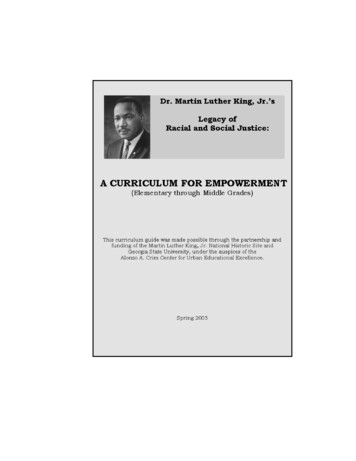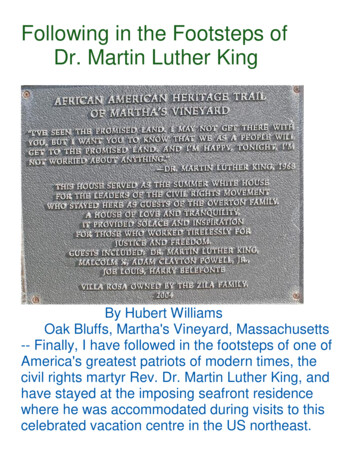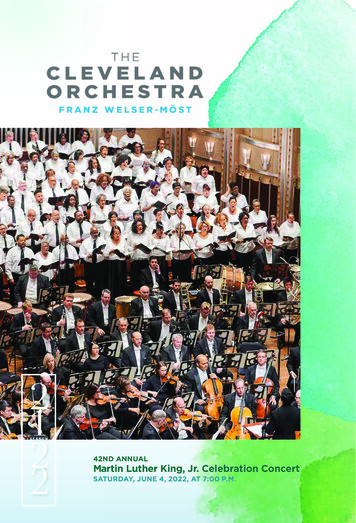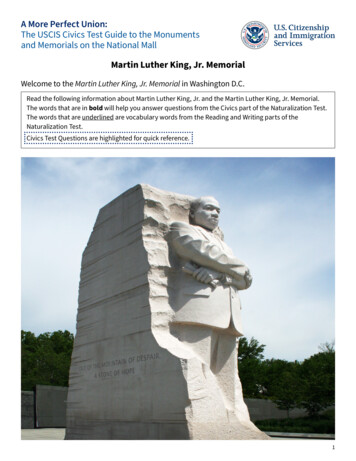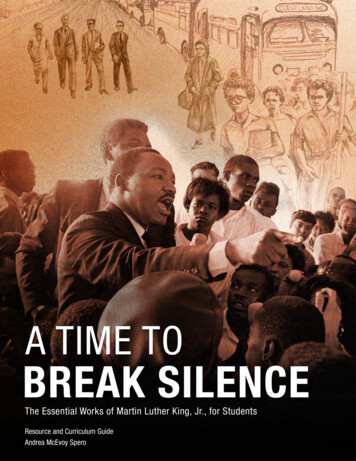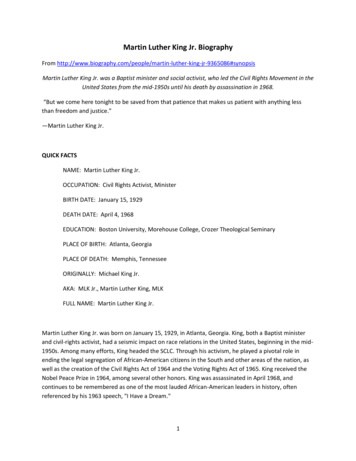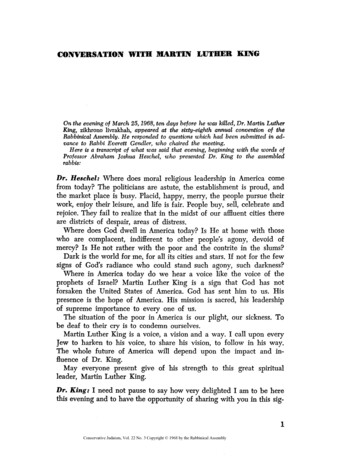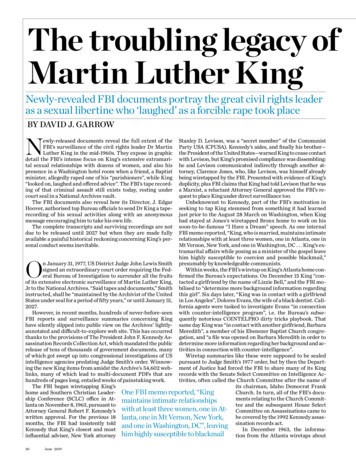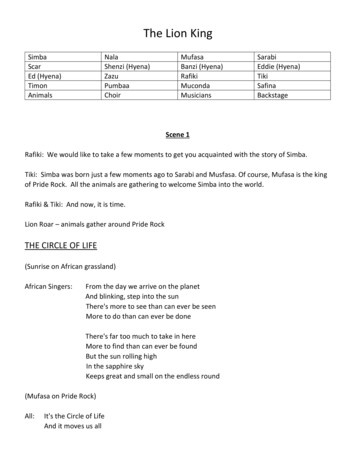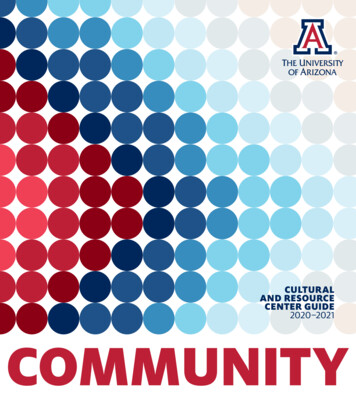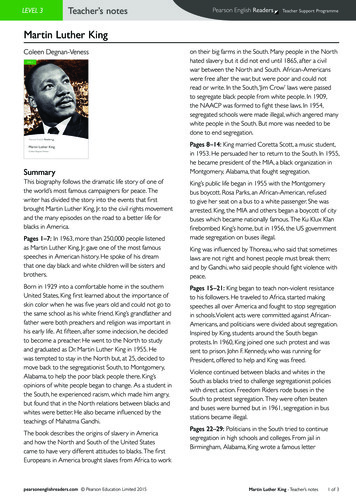
Transcription
level 3Teacher’s notesTeacher Support ProgrammeMartin Luther KingColeen Degnan-VenessSummaryThis biography follows the dramatic life story of one ofthe world’s most famous campaigners for peace. Thewriter has divided the story into the events that firstbrought Martin Luther King, Jr. to the civil rights movementand the many episodes on the road to a better life forblacks in America.Pages 1–7: In 1963, more than 250,000 people listenedas Martin Luther King, Jr. gave one of the most famousspeeches in American history. He spoke of his dreamthat one day black and white children will be sisters andbrothers.Born in 1929 into a comfortable home in the southernUnited States, King first learned about the importance ofskin color when he was five years old and could not go tothe same school as his white friend. King’s grandfather andfather were both preachers and religion was important inhis early life. At fifteen, after some indecision, he decidedto become a preacher. He went to the North to studyand graduated as Dr. Martin Luther King in 1955. Hewas tempted to stay in the North but, at 25, decided tomove back to the segregationist South, to Montgomery,Alabama, to help the poor black people there. King’sopinions of white people began to change. As a student inthe South, he experienced racism, which made him angry,but found that in the North relations between blacks andwhites were better. He also became influenced by theteachings of Mahatma Gandhi.The book describes the origins of slavery in Americaand how the North and South of the United Statescame to have very different attitudes to blacks. The firstEuropeans in America brought slaves from Africa to workpearsonenglishreaders.com Pearson Education Limited 2015on their big farms in the South. Many people in the Northhated slavery but it did not end until 1865, after a civilwar between the North and South. African-Americanswere free after the war, but were poor and could notread or write. In the South, ‘Jim Crow’ laws were passedto segregate black people from white people. In 1909,the NAACP was formed to fight these laws. In 1954,segregated schools were made illegal, which angered manywhite people in the South. But more was needed to bedone to end segregation.Pages 8–14: King married Coretta Scott, a music student,in 1953. He persuaded her to return to the South. In 1955,he became president of the MIA, a black organization inMontgomery, Alabama, that fought segregation.King’s public life began in 1955 with the Montgomerybus boycott. Rosa Parks, an African-American, refusedto give her seat on a bus to a white passenger. She wasarrested. King, the MIA and others began a boycott of citybuses which became nationally famous. The Ku Klux Klanfirebombed King’s home, but in 1956, the US governmentmade segregation on buses illegal.King was influenced by Thoreau, who said that sometimeslaws are not right and honest people must break them;and by Gandhi, who said people should fight violence withpeace.Pages 15–21: King began to teach non-violent resistanceto his followers. He traveled to Africa, started makingspeeches all over America and fought to stop segregationin schools.Violent acts were committed against AfricanAmericans, and politicians were divided about segregation.Inspired by King, students around the South beganprotests. In 1960, King joined one such protest and wassent to prison. John F. Kennedy, who was running forPresident, offered to help and King was freed.Violence continued between blacks and whites in theSouth as blacks tried to challenge segregationist policieswith direct action. Freedom Riders rode buses in theSouth to protest segregation. They were often beatenand buses were burned but in 1961, segregation in busstations became illegal.Pages 22–29: Politicians in the South tried to continuesegregation in high schools and colleges. From jail inBirmingham, Alabama, King wrote a famous letterMartin Luther King - Teacher’s notes 1 of 3
level 3Teacher’s notesTeacher Support ProgrammeMartin Luther Kingexplaining why black people were fighting segregation.After his release, thousands of children marched inBirmingham. The police attacked them with water anddogs, which shocked America and attracted the world’sattention. President Kennedy supported King and began todraw up a civil rights bill.Then there was the march on Washington. It drew acrowd of more than 200,000 marchers including 50,000whites, and it is where King gave his famous “I have adream” speech. In 1964, King won the Nobel Peace Prize.Pages 30–41: King began to fight for voting rights forAfrican-Americans. His arrest in Selma, Alabama in 1965,was reported in newspapers and on television acrossthe country. More protest marches and more violencefollowed. Finally, President Johnson signed a new VotingRights law, as King and Rosa Parks stood beside him.Some gains had been made, but many African-Americansstill lived in terrible poverty. As they became radicalized,they stopped listening to King’s message of non-violentprotest. New leaders, such as Malcolm X and StokelyCarmichael, told them to fight for their freedom. Thisanger culminated in the Watts riots in Los Angeles in1965.In 1968, King made his last speech in front of an audiencein Memphis. The next evening he was shot dead in aparking lot. Blacks have equal political and voting rightstoday, thanks to the work of Martin Luther King at thehead of the civil rights campaign. On Martin Luther KingDay every year, Americans celebrate African-Americanhistory and remember King and his message of equality.Background and themesDedication to a cause: This biography shows thatMartin Luther King, Jr. dedicated his life to his cause,and although he had a wife and four children, his timewas not his own. The cause of civil rights for AfricanAmericans was so big and his campaigns made it so active,that he could never rest. He lived a very public life in frontof the world’s press. His heart, mind and actions wereruled by his religious and political beliefs; he was driven.Other protest leaders who have given up their lives totheir cause include Mahatma Gandhi, Nelson Mandela andAung San Suu Kyi in Burma, who has left her family andchildren in England to fight for democracy in her country.pearsonenglishreaders.com Pearson Education Limited 2015Non-violence: The central theme of King’s campaignfor civil rights was non-violence. It worked better forKing in the US than it did for Gandhi in India, whereindependence was accompanied by terrible fightingbetween Muslims and Hindus. There are lots of examplesin King’s campaign of non-violent protest working. Hiscampaign brought huge publicity and because King taughtblacks to meet the whites with love, not hate, it madethe whites look silly and evil in the eyes of the world. Forexample, when students organized lunchtime protests(see page 18), the world saw white men arresting peacefulblacks because they sat in the wrong seats in a lunch barin Woolworth’s. When children marched in Birmingham,Alabama (see page 24), police used water cannons anddogs against them, arrested them and put them in jail.Publicity: Another important weapon in King’s fightagainst injustice was publicity. For many poor blacks, lifewas simply a struggle to feed their families and keep aplace to live. King needed to reach all those people andshow them that their lives could be better. He madespeeches all over America. He held meetings. Whenhe was arrested, it made world news. Black AfricanAmericans became radicalized and wanted to fight. Somewent further than King intended, and used violence, as inthe 1965 Watts riots in Los Angeles. But he taught themthat they could change things. Publicity then includedposters, newspapers, meetings, word of mouth, marches,demonstrations, radio, and early television.Racism: The central wrongdoing of this story is racism.The belief by one race that they are better than anotheror that they can rule another is behind much humanconflict. The early slave traders treated black people asanimals. It has taken centuries for most whites to stopbelieving they are superior to blacks. Many whites todaystill believe they are superior to blacks, in many parts ofthe world, Racism exists in more or less extreme formsin most cultures, and is one of the most pressing issues inworld politics today.Discussion activitiesBefore reading1Discuss: Ask the class to tell you anything they knowabout African-American history. Ask students tocome up to the board and write a name, a date, or afact relating to African-American history. Encouragestudents to mention slavery, the American Civil War,segregation, civil rights, etc.Martin Luther King - Teacher’s notes 2 of 3
level 3Teacher’s notesTeacher Support ProgrammeMartin Luther KingIntroductionAfter reading2Discuss: When students have read the Introduction(page iv) read out these sentences and ask thestudents to say if they are true or false. If they arefalse, ask students to say the correct sentence.a Martin Luther King, Jr.’s birthday is a national day inthe USA.b African-Americans suffered because of laws in theAmerican North.c Segregation means that a black person can sit nextto a white person on the bus.d King wanted all protests and marches to be violent.e King’s dream was for a better world for everyone.7Pages 15–21After reading8Pages 1–7After reading345Role play: Students work in small groups. Ask eachgroup to choose one of these scenes and prepare toact it out in front of the class. Encourage students toinclude both dialogue and action in their role play. King is a young boy. He has just been told to stopplaying with the little white boy by the white boy’sparents. Now he is at home. King’s parents are nowexplaining to him how difficult life is for black peoplein the US. King is fifteen. He has started to question the church’steachings. He is telling his father, Daddy King, that hedoes not want to become a preacher. His father is nothappy about this. King is seventeen. He has just preached for the firsttime in his father’s church. He was nervous but hewas a success. Now he is talking to Daddy King, whois proud of him.Discuss: Divide the class into groups to discuss thesequestions.Imagine you are King just after he graduated fromcollege in Boston. Would you stay in the North or wouldyou return to the South? Why?Write: Ask students to imagine they are living in theUS in 1953. They should write a letter to anewspaper about the Jim Crow laws in the South.What are some examples of these laws? Why are theywrong? What are the results of these laws? What canpeople do to change them?Pages 8–14After reading6Discuss and write: Ask students to read aboutRosa Parks on page 10 again. Put them into pairs.Tell them to imagine they are young reporters onMontgomery newspapers. Half of the pairs work fora white newspaper. The other half work for a blackpearsonenglishreaders.com Pearson Education Limited 2015newspaper. They prepare their reports. Comparereports across the class, looking at ways students haveused to express bias and give only one side of thestory.Discuss: Ask students to discuss these questions insmall groups.Why was the Montgomery bus boycott successful? Doyou know about any other boycotts? Do you thinkboycotts are usually successful? Why or why not?9Discuss and write: Put students in pairs or smallgroups. Give each pair one of the following episodesin the story. Ask them to summarize it in two orthree sentences and then read their summary to theclass:King’s trip to Ghana, p. 15; King’s arrest onSeptember 3, 1958, pages 16 –17; Rich’s lunch barp. 18; the vote for US president, November 1960;the May 15 Freedom Ride p. 20.Write: Imagine you were on the Freedom Ride buson May 15 near Anniston, Alabama. Write a fewsentences to someone in your family about whathappened. How did you feel? What did you do?Pages 22–29After reading10 Discuss: Divide the class into groups to discuss thesequestions.King wrote a letter from Birmingham jail. Who washe writing to? Why did some white people want blackpeople to “wait”? Why did King say that it was difficultfor black people to wait?11 Write: Ask students to write in one or two sentenceswhy they think the following things were important inthe campaign against segregation.Little Rock High School, p. 22; the children’s march,pages 24–25; the march on Washington, pages 27–28;the Sixteenth Street Baptist Church, p. 28.Pages 30– 41After reading12 Discuss: The story of Martin Luther King, Jr. is thestory of the fight by African-Americans to change aracist society into a non-racist society. Ask students tothink about why we have racism and where it comesfrom. Invite them to talk about racism in their ownculture. Have they experienced racism themselves?What is the best way to respond to racism?13 Discuss: Martin Luther King, Jr. was a hero to youngblack people in the 1950s and 1960s. Who are today’sheroes? What battles do they need to fight in today’sworld?Martin Luther King - Teacher’s notes 3 of 3
level 3Activity worksheetsTeacher Support ProgrammeMartin Luther KingWhile readingPages 1–71 Look through this section of the book quickly.Find the dates in the box and match themwith the things that happened.Photocopiable3black2Choose the correct answer.a King missed two grades in school because .1) he travelled with his father.2) he had to go to a school for blackchildren.3) he did very well in school.b King finally decided to become a preacherbecause of .1) Dr Mays.2) Daddy King.3) his mother.c King’s opinions about white people changedbecause .1) white people in the South were kind tohim.2) he studied the ideas of an Indian teacher.3) he was voted president of his class.d Slaves were brought to America becausewhite people needed .1) farm workers.2) workers on ships.3) workers in the North.pearsonenglishreaders.com Pearson Education Limited 2015changedfreepoorwhiteAfter the North won the war, African-americansin the South were finally (a) but they were very (b) Jim Crowlaws did not let (c) people go to(d) schools. African-Americansorganized the NAACP because they thought theJim Crow laws had to be (e) .1807 1865 1896 February 15, 1948May 16, 1954 December 1, 1955December 1955 August 28, 1963a King became a preacher. b King made his ‘I have a dream’ speech. c The United States passed a law that acceptedsegregation in all states. d Rosa Parks was arrested on the bus inMontgomery, Alabama. e Slave ships became illegal in America. f Segregation in United States schools becameillegal. g Slavery ended in the United States. h The civil rights campaign in the United Statesbegan. Complete these sentences with a word fromthe box.Pages 8–144 Answer these questions.a What job did Coretta Scott have before shemarried King?b What job did she have after they weremarried?c Why did she return to the South with Martin?d How many children did she and Martin have?e Why was she worried about Martin?5Why do you think Rosa Parks refused to giveher seat to a white passenger? Talk with afriend or write a paragraph with your ownideas.6Which of the following were for theMontgomery bus boycott? Which wereagainst?the bus company the KKKthe black taxi companies the politiciansthe MIA the police world opinion7Answer these questions.a Why did Henry Thoreau refuse to pay moneyon his earnings to the US government?b What did Mahatma Gandhi help to win withhis peaceful protests?Pages 15–218 What happened first? Put the sentences in theright order and number them, 1–10.a c King and his wife see suffering in Nigeria.b c King and Abernathy visit Richard Nixon.c c King appears on the cover of Timemagazine.d c A black woman tries to kill King.e c Ralph Abernathy’s house is bombed.f c King and other black leaders start theSCLC.Martin Luther King - Activity worksheets 1 of 2
level 3Activity worksheetsTeacher Support ProgrammeMartin Luther Kingg c King chooses to spend two weeks in jail.h c King tries to speak to Abernathy in acourt room.i c President Eisenhower refuses to help King.j c King and his wife fly to Ghana.9Answer these questions.a Why were King’s arrests “good for hiscampaign”?b Why were King and the students given steakfor their first meal in prison in October 1960?c Why was King worried when he was taken toReidsville State Prison?d Why didn’t King help John F. Kennedy’scampaign for president?Pages 22–2910 Find the right name.a The President of the United States in 1962 .b A Birmingham preacher .c An African-American student .d Police chief, Birmingham, Alabama .e State leader, Alabama .f State leader, Arkansas .g A politician in Washington, D.C. .1) Bull Connor2) Fred Shuttlesworth3) George Wallace4) John F. Kennedy5) James Meredith6) Robert Kennedy7) Orval Faubus11 Answer these questions.a Why did President Eisenhower send soldiersto Little Rock, Arkansas, in 1957?b In King’s letter from Birmingham Jail, whatdoes “Wait!” mean for black people?c What did people think when they saw U.S.policemen and dogs attack black childrenon a protest march?d Why was John F. Kennedy worried about thiscivil rights bill?e How many whites joined the march onWashington?f Two terrible things followed King’s “I havea dream” speech in August 1963. What werethey?g Why was Dr Mays’ big dinner part of King’sdream?pearsonenglishreaders.com Pearson Education Limited 2015PhotocopiablePages 30–4112 What happened first? Put the sentences in theright order and number them, 1–8.a c King meets President Johnson.b c King and 400 people march to a Selmacourthouse.c c King asks protesters around the countryto come to Selma.d c President Johnson promises to give allAmericans voting rights.e c Police arrest King, Abernathy andhundreds of marchers.f c King writes a letter from Selma Jail.g c President Johnson asks his government topass the Voting Rights law.h c An African-American protester is killed infront of his parents.13 Complete these sentences with a word fromthe box.defendendgetgivelistenriotworka By the middle of the 1960s, many AfricanAmericans did not to Kingany more.b Malcolm X said that blacks should themselves against the whiteenemy.c Stokely Carmichael thought that black peopleand white people could not together.d King did not want people to in the streets.e King wanted President Johnson to the war in Vietnam.f King also wanted President Johnson to jobs to poor people.g President Johnson wanted to information about King’s private life.14 There are mistakes in these sentences. Writethe correct information.a The day before he died, King spoke toworkers who wanted more education.b King was killed outside a church.c There were no riots when Americans heardthat King was dead.d Only a few people watched King’s funeral ontelevision.e King’s killer was sent to prison for a year.Martin Luther King - Activity worksheets 2 of 2
level 3Progress testTeacher Support ProgrammeMartin Luther KingPhotocopiable1 Complete the sentences with a word from the box.bookschurchcloth collegeseats speechgunnamea King changed his the night beforehe spoke in Washington, D.C.b King’s father changed his after a tripto Germany.c King loved sports and when he wasin school.d King graduated from a in the Northin 1951.e King’s first job was at a inMontgomery, Alabama.f After he won a prize for a speech, the youngKing and a teacher were told to give their to white people.g On a train, a waiter put a in front ofKing’s face because he was black.h After he read Gandhi, King could talk calmly to awhite student who had a .2 Write right ( ) or wrong ( ) or it does not say (?)a King’s father did not want his son to feellike a slave.cb Slavery in America ended when slave shipswere made illegal.cc After 1865, African-Americans wanted togo to the North.cd W.E.B. DuBois was against the Jim Crowlaws.ce After 1954, there was no more segregationin the US.cf The US government decided to help blacksoldiers buy houses.cg Ralph Abernathy helped King organizethe MIA.c3 There are mistakes in these sentences. Write thecorrect information.a King met Coretta Scott in Montgomery.b After she married King, Coretta taught and gavethe money to the civil rights campaign.c On December 1, 1955, Rosa Parks gave her seat toa white person on the bus.d The KKK was an organization in the South whichhelped black people.pearsonenglishreaders.com Pearson Education Limited 2015e Thoreau was an American lawyer who refused toobey laws that he did not agree with.f Gandhi was an Indian who studied law and believedin violent protest.4 Complete these sentences.a In 1957, an African leader invited King to visit thecountry of .b King was attacked in a New York . .c Judge Mitchell tried to keep King in . .d In 1960, King’s father asked people to vote for . .e The Freedom Riders rode buses in the South andsat in . .f On May 19, 1961, King was worried because peopleoutside Abernathy’s church were throwing . .g After King phoned him, Robert Kennedy promisedto send more . .5 Are these sentences true (T) or false (F)? Correctthe false ones.a King wrote his letter from Birmingham jailto a group of white policemen.cb During the Children’s March, children wereattacked with water and dogs.cc There were more than 200,000 blackmarchers in the March on Washington.cd The men who bombed the Sixteenth StreetBaptist Church were sent to prison quickly.ce At 35, King became the youngest winner ofthe Nobel Peace Prize.c6 Underline the correct words.a King asked to put 400 African-Americansin white schools / on the voting list in Selma,Alabama.b On “Bloody Sunday”, the violence by police /protesters in Selma was reported around thecountry.c King spoke about voting rights on the steps ofthe courthouse / state building in Montgomery,Alabama.d Malcolm X was against / for King’s peaceful protests.e Stokely Carmichael became the leader of theFreedom Riders / the SNCC.f King said that the riot in Watts happened becausepeople were against the war / poor and hopeless.g There were more riots / wars in the summer of1967.Martin Luther King - Progress test 1 of 1
level 3Answer keysTeacher Support ProgrammeMartin Luther KingBook keya civil rights, freedom, peace, voting rightsb boycott, demonstrate, march, protest, riot(also, possibly, bomb, violence)2 a no b yes c no3 Open answers4 a Washington, D.C.b Daddy King (Martin Luther King’s father)c Atlanta d Montgomery (Alabama)e Connecticut5 a 1620 b 1807 b 1861–65 d 1896 e 1909f 1954 g 19556 – 9 Open answers10 a b c d e f g 11 a Mrs. Parks was arrested for refusing to give her seatto a white person.b Martin Luther King joined the boycotters in jail.c Segregation on buses in the United States becameillegal.12–14 Open answers15 a 3 b 4 c 2 d 1 e 516 : b, c, e17 a King said this to the people in his church becausehe was very worried. He was prepared to die forhis people.b A guard at the court room said this to King becauseKing tried to get inside. King wanted to speak toAbernathy.c King thought this because the police were drivinghim 500 kilometers through dark country roads inthe early hours of the morning.d Daddy King said this to the people at EbenezerChurch because he was grateful to JFK for his help.18 a After he talked to the judge, King was freed on bail.b He sent soldiers to stop the segregationists’ attackon the Freedom Riders.c They moved people out of a church wheresegregationists were becoming violent.19–20 Open answers21 a nine b riot c King’s d demonstrationse police22 : a, c, e1pearsonenglishreaders.com Pearson Education Limited 201523 a He was the state leader of Alabama and hepromised to continue segregation in the statecolleges.b The SCLC organized protest marches for the civilrights campaign. It held important discussions withbusiness and church leaders.c He was Birmingham’s police chief and asegregationist. He gave orders to the police toarrest and attack black children.24 Open answers25 a Selma, Alabama b Montgomery, Alabamac Washington, D.C. d South Vietname Watts, in Los Angeles f Chicagog Memphis, Tennessee h Memphis26 a This made King happy because black people finallywon the right to vote.b This worried King because he did not believe inviolence.c This worried King because he did not want moreriots and violence.d This worried King because he did not believe in theuse of violence. The money was needed for housesfor poor people in the U.S.e This made King happy. He and black Americans willdie and go to the Promised Land.27–34 Open answersDiscussion activities key1 Open answers2 a Trueb African-Americans suffered because of laws in theAmerican South.c Segregation means that a black person cannot sitnext to a white person on the bus.d King wanted all protests and marches to benon-violent.e True3 –13 Open answersActivity worksheets key1abcdefghFebruary 15, 1948August 28, 19631896December 1, 19551807May 16, 19541865December 1955Martin Luther King - Answer keys 1 of 2
level 3Answer keysTeacher Support ProgrammeMartin Luther King234567891011121314a 3 b 1 c 2 d 1a free b poor c black d white e changeda She was a singer.b She was King’s secretary.c Because King’s work was important.d Four.e Because people wanted to kill him.Open answersThe black taxi companies, the MIA and world opinionwere for the boycott. The bus company, the KKK, thepoliticians and the police were against the boycott.a Because he didn’t agree with the U.S. war withMexico.b Freedom from British rule.a 3 b 5 c 7 d 10 e 1 f 6 g 9 h 8i 4 j 2a Because the newspapers always wrote about it.b Because the world was watching.c Because it was a prison for the worst criminals.d He said he wasn’t a politician.a 4 b 2 c 5 d 1 e 3 f 7 g 6a Because Orval Faubus, state leader, was breakingthe law.b “Never!”c They could not believe their eyes.d He did not want another war between the Southand the North in America.e About 50,000.f John F. Kennedy was shot dead. The KKK murderedfour young school girls in a church in Birmingham.g Because black and white city leaders sat down andate together.a 4 b 1 c 7 d 3 e 2 f 5 g 8 h 6a listen b defend c work d riot e endf give g geta King spoke to workers who wanted higher pay onthe day before he died.b King was killed outside of a hotel.c There were riots in 110 cities when Americansheard that King was dead.d One hundred and twenty million people watchedKing’s funeral on television.e King’s killer was sent to prison for thirty years.pearsonenglishreaders.com Pearson Education Limited 2015Progress test key123456speech b name c books d collegechurch f seats g cloth h gun b c ? d e f g ?King met Coretta Scott in Boston.After she married King, Coretta sang and gave themoney to the civil rights campaign.c On December 1, 1955, Rosa Parks did not give herseat to a white person on the bus.d The KKK was an organization in the South whichattacked black people.e Thoreau was an American writer who refused toobey laws that he did not agree with.f Gandhi was an Indian who studied law and believedin peaceful protest.a Ghana b bookstore c prisond John F. Kennedy (JFK) e “Whites only” seatsf rocks g soldiersa F – King wrote the letter to a group of whitepreachers.b Tc F – There were more than 200,000 marchers andalmost one quarter were white.d F – They were not sent to prison for many years.e Ta on the voting listb policec state buildingd againste the SNCCf poor and hopelessg riotsaeaabMartin Luther King - Answer keys 2 of 2
the same school as his white friend. King's grandfather and father were both preachers and religion was important in his early life. At fifteen, after some indecision, he decided to become a preacher. He went to the North to study and graduated as Dr. Martin Luther King in 1955. He was tempted to stay in the North but, at 25, decided to
